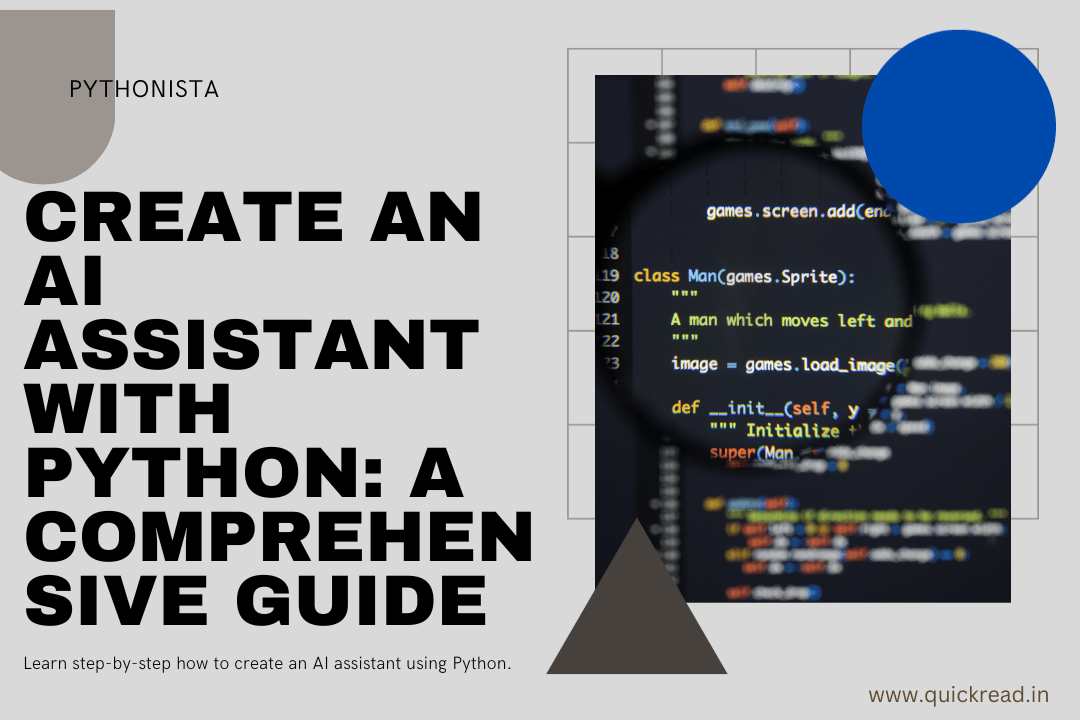Introduction
Artificial Intelligence (AI) is transforming every industry today. With the right skills, you can build AI applications to automate tasks, gain insights from data, and accomplish feats not possible otherwise. Python, with its extensive AI libraries and easy to learn syntax, is the perfect language to get starting with building AI apps.
This article provides a step-by-step guide to create an AI assistant with python from scratch.
Steps to Create an AI Assistant with Python
At a high level, we will:
- Install Python environment
- Load and preprocess data
- Train machine learning models
- Evaluate models
- Deploy a chatbot web application
Let’s explore each step:
1. Install Python Environment
First, we need a Python environment with key libraries:
pip install numpy scipy scikit-learn tensorflow keras nltkThis installs popular packages for math, science, machine learning, deep learning and NLP.
We’ll also need an editor like VS Code for writing code.
Optionally, you can use Anaconda to get a ready Python environment with Jupyter notebooks.
2. Load and Preprocess Data
Our goal is to train AI models to understand natural language and provide relevant responses. For this, we need conversation data to train on.
Let’s take the classic Cornell Movie Dialogs dataset containing over 220k fictional conversations.
We need to:
(a) Load raw text data into dataframe:
import pandas as pd
df = pd.read_csv('movie_lines.tsv', delimiter='\t')(b) Perform preprocessing:
- Remove blank rows
- Fix encoding issues
- Lowercase text
- Remove punctuation
- Tokenize to split sentences into words
After cleaning, we have rows containing dialog snippets ready for modeling.
3. Train Machine Learning Models
With structured data ready, we can train some ML models to understand language patterns.
We’ll train two model types:
(A) Word Embeddings
Word embeddings convert words into numeric vector representations capturing semantics. It trains on association between nearby words.
We can use the Word2Vec algorithm:
from gensim.models import Word2Vec
sentences = [[dialogue_line1_words], [dialogue_line2_words], ...]
model = Word2Vec(sentences, vector_size=100, workers=4)
print(model.wv['hello']) # prints 100-dim vector for 'hello'Now we have vectors encapsulating what words mean in relation to other words.
(B) Sequence Models
Recurrent neural networks (RNN) like LSTMs can model language by learning long-range sequential patterns.
We can train a sequence model to predict the next word in text:
from tensorflow import keras
model = keras.Sequential()
model.add(keras.layers.LSTM(128))
model.add(keras.layers.Dense(vocab_size))
model.compile(loss='sparse_categorical_crossentropy')
model.fit(text_sequences, next_word_labels, epochs=10)This model learns relations between current words and next words in sentences. We can generate text probabilistically using the trained LSTM.
4. Evaluate ML Models
After training models, we need to evaluate accuracy metrics like perplexity and recall:
w2v_model.evaluate_word_pairs(pairs=[('man', 'woman')])
lstm_model.evaluate(x_test, y_test)This gives us confidence that models worked reasonably well before production use.
For text models, we also visually inspect some outputs to validate quality.
5. Deploy a Chatbot Web Application
Finally, we can build an end-user chatbot app consuming our machine learning models.
There are two key components:
We wrap LSTM model logic into a web API endpoint using Flask:
from flask import Flask
app = Flask(__name__)
@app.route("/chat")
def chat():
user_input = request.args.get('msg')
bot_response = lstm_model.predict(user_input)
return {"bot": bot_response}
if __name__=="__main__":
app.run()This allows sending user messages and returning bot responses as JSON over HTTP.
B. Chat Widget
For the UI, we can use React.js to query our bot API and render an interactive chat screen:
function ChatWindow() {
function handleSend(event) {
var user_msg = event.target.value;
fetch('/chat?msg='+user_msg)
.then(response => response.json())
.then(data => {
// show bot response
});
}
return (
<div>
<input onKeyDown={handleSend} /> {/* input box */}
<div> {/* bot messages */} </div>
</div>
);
}The React component calls our Python bot API endpoint to display interactive responses.
And we have a complete conversational AI assistant running off models trained using Python!
Building Custom AI Capabilities
While we used a simple conversational assistant to illustrate concepts, much more capable AI systems can be developed using Python’s extensive libraries tailored for tasks like:
- Computer vision (OpenCV, PIL)
- Natural language processing (NLTK, spaCy)
- Speech recognition (SpeechRecognition, pyaudio)
- Recommendation systems (Surprise, LensKit)
- Anomaly detection (PyODDS, scipy)
You can pick and choose components fitting your use case. The key is breaking down application goals into discrete AI capabilities leveraging Python’s arsenal of building blocks – data manipulation (NumPy, Pandas), machine learning (sklearn, Keras), data visualization (Matplotlib, Plotly) etc. to assemble your unique AI solution.
Next Steps
We covered the key development steps at a high level to build conversational AI with Python. Some enhancements for taking it further:
- Expand labelled datasets – use transfer learning and data augmentation techniques to minimize hand labeling effort while increasing model robustness.
- Improve accuracy – leverage ensembles, optimize hyperparameters, leverage Transformer architectures like BERT.
- Cloud deployment – containerize models in Docker and deploy to services like AWS Elastic Beanstalk for scalable production hosting.
- Add channels – expose AI assistant via chat interfaces, voice interfaces and smartphone apps to boost reach.
- Active learning – enable closed loop retraining by capturing user feedback to continuously expand capabilities.
I hope the hands-on examples give you a template to get started and spark AI application ideas you can build using Python’s rich set of libraries. Let’s move to some common reader questions.
Frequently Asked Questions
Q: Do I need specialized hardware to build AI apps with Python?
Most basic AI prototypes can be built on consumer laptops for proof-of-concept and learning before investing in GPU/TPU clouds for large scale model training. Toolkits like Google Colab provide free access to GPU resources reducing hardware barriers.
Q: Which machine learning libraries are best for beginners?
Beginner friendly Python ML libraries include Scikit-Learn for traditional ML, Keras for neural networks and PyTorch for flexibly architecting deep learning models. They have well-documented APIs, pre-trained models and wide adoption making learning pathways smoother.
Q: Where can I find datasets for training custom AI models?
Great places to find labelled datasets include Kaggle Datasets, Google Dataset Search, PapersWithCode Dataset Cards and dataset repositories of universities like Stanford and CMU. Start with existing relevant datasets before attempting expensive data collection for niche domains.
Q: What real-world products are powered by AI assistants built using Python?
Python AI is enabling use cases like Alexa Skills chatbots, Netflix show recommenders, Siri Suggestions, Google RankBrain search relevance, C3.ai predictive inventory management, disease diagnosis systems of PathAI and much more.
Q: Which tools help take machine learning models from Python code into production?
MLOps tools like Seldon Core,cnvrg.io, Comet.ml, MLflow and Kubeflow help solve challenges in dependency management, reproducibility, model monitoring and retraining workflows taking models built with Python frameworks into reliable and robust production across various deployment environments.
I hope this guide served as a practical launchpad for how to start building AI systems using Python even as a beginner. Let me know if you have any other questions!


